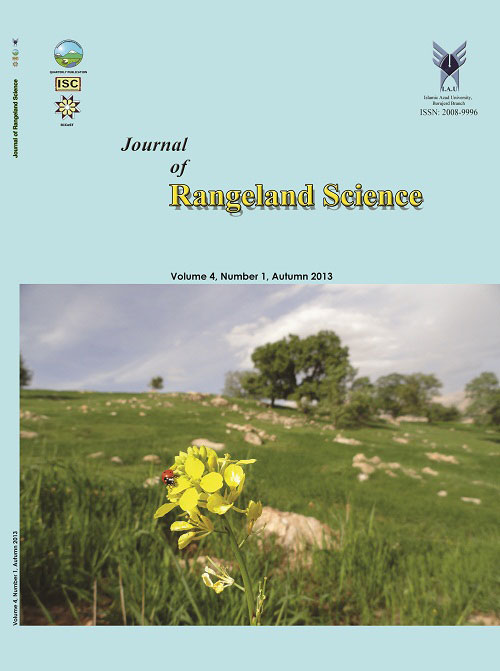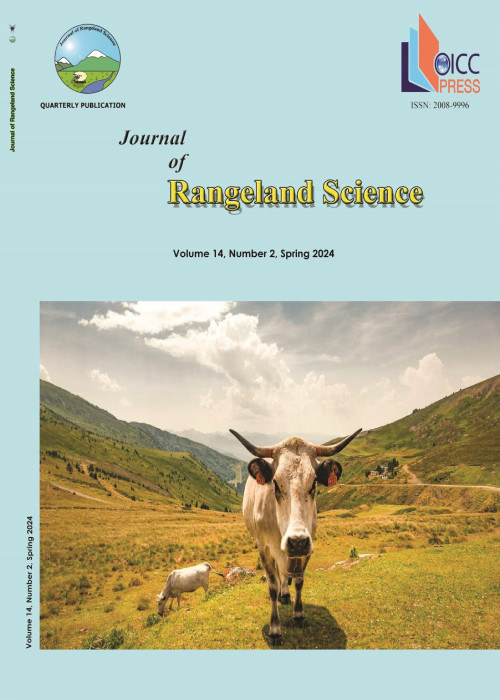فهرست مطالب

Journal of Rangeland Science
Volume:4 Issue: 1, Winter 2014
- تاریخ انتشار: 1393/07/01
- تعداد عناوین: 8
-
-
Pages 1-13Land use may be regarded as one of the most important factors affecting the environment with respect to human activities. So far, destroying the rangelands and changing them into the waste lands and poor rangelands has been proposed as the most significant variations of land use done by human beings. This paper has been conducted to evaluate the variations of vegetation percentage and land uses in Barabad-Darook village with the area of 1522.99 km2 in Sabzevar city during 1987-2007. Thus, using satellitebased images of TM and ETM+, the most appropriate band composition has been selected and a mapping of vegetation cover and land use was provided through maximum likelihood algorithms to correct the errors of geometer and radiometer highlights. At last, the accuracy of extracted maps was to be determined by the means of overall accuracy test and Kappa coefficient in order to achieve the validation of research process. Results indicate that waste lands have been increased from 84.75 to 89.49 and third-rated rangelands have been reduced from 6.85 to 4.14 percent. On the other hand, first-rated rangelands were reduced from 0.03 to 0.01 percent which covers 5170791.45 m2 of total area in the district. Also, the results show that irrigated agricultural lands are to be decreased from 6.53 to 0.07 percent. In total, due to improper exploitations of regional water resources and vegetation cover, land uses have been changed into fallow and waste lands leading to the decrease in the percentage cover of high quality rangelands. Research findings demonstrate that considering the accepted accuracy, new remote sensing technology can be applied to exactly estimate the area changes of land use and vegetation.Keywords: land use, Land cover change detection, Remote sensing, GIS
-
Pages 14-22Considering forage grass species, germination is one of the important stages concerning the growing stage that is often influenced by environmental stresses, particularly salinity and drought stresses. Thus, this study aims to assess the effects of salinity and drought stresses on germination characteristics and seedling growth of desert wheatgrass, Agropyron desertorum (Fisch. ex Link) Schult. in laboratory conditions. Two separate experiments were conducted using completely randomized design with four replicates. Six salinity treatments (control, 50, 100, 150, 200 and 300 mM NaCl) and six drought treatments (control, -0.2, -0.4, -0.6, -0.8 and -1 MPa polyethylene glycol) were utilized in four replicates. Germination percentage and rate were calculated while computing the germinated seeds every day. Growth parameters (rootlet, shoot and seedling length), allometric index and seed vigor have been accordingly given. For each experiment, one-way ANOVA was used to determine significant effects of treatments and mean comparison was done by the means of Duncan method using SPSS software. Results showed that salinity and drought stresses had the significant effects on germination and growth indices of Agropyron desertorum so that germination rate and percentage, root length, shoot length, seedling length and seed vigor indices were decreased by increasing the concentrations of salinity and drought treatments. Also, seed germination and growth were observed only until -0.4 MPa drought level so that germination at φs = -0.6 MP was completely stopped.Keywords: Salinity, drought stresses, Germination, Vigor Index, Agropyron desertorum
-
Pages 23-33Due to the increase of changes in the land uses mainly resulting from human interferences, monitoring the changes and evaluating their trend and environmental effects for future planning and management are essential. In the present study, an attempt is made to observe the changes which had occurred in Ardestan area during a period of 30 years using some satellite images. Different kinds of data for every year in three time intervals of 1976, 1990 and 2006 were retrieved from the images; then, using LMM model and GIS software, the rate of changes for each piece of data was calculated. Different methods of classification were tested. In this study, four classes of land uses were gained for each year. The results show that for 30 years, the area of residential zones had increased from 31. to 528.3 ha and the area of agricultural lands had decreased from 440.6 to 346.3 ha. Also, considering the changes of the area, almost 31% of the total area of the region had undergone some changes during the studied period which is a symptom of man interference. Studies have also shown that changes of rangeland into residential lands had occupied the maximum area during last 30 years.Keywords: Change detection, LMM model, land use, Remote sensing technique, Land cover
-
Pages 34-42Understanding the plant species diversity could be used as an important indicator applied for the natural areas management. The aim of this study was to investigate the relationships between soil characterizes with distribution and diversity of plant in vegetation types in Karvan district (located in west of Isfahan province). For this purpose, three vegetation types were selected as follows: Scariola orientalis-Astragalus gossypinus (Sc.or-As.go), Hordeum fragile-Astragalus gossypinus (Ho.fr-As.go) and Cousinia bachtiarica-Astragalus gossypinus (Cu.ba-As.go). Then, four transects random sampling - systematic bias to the general and lateral slope of the region in each vegetation type were placed and the name and other characterize of the plants were recorded by 90 of randomly quadrate one m2, also the soil samples of the start and end of each transect from two different depths (0-20 and 20-75 cm) of soil were taken. Soil samples were analyzed and the physicochemical factors were measured. Diversity indices such as Menhinick, Margalef and Fisher alpha were analyzed by VMSP software and soil data were analyzed by PC-ORD software. The results of numerical indices showed a different diversity index in vegetation types and there were significant correlation between some soil properties and diversity index. It was concluded that the Sc.or-As.go type had the highest diversity in comparison with the other vegetation types (Ho.fr-As.go and Cu.ba-As.go). Finally soil properties such as organic matter, clay and soil depth had positive and the amount of lime and gypsum had negative correlation with species diversity.Keywords: Soil factors, Diversity indices, Vegetation types, Karvan rangeland
-
Pages 43-61Tajikistan is a hotspot of plant and animal species diversity and endemism and is important for the conservation of biodiversity on a global scale. The country is located at a biological crossroads. Species from Central and Northern Europe, Central Asia, the Middle East, and North Africa mingle here with endemics found nowhere else. The richness of Tajikistan‘s biodiversity shows up at the genetic, species, population, and ecosystem levels. There are many relic and endemic species, with most of the components of biodiversity vulnerable to anthropogenic factors. Proximate threats such as poaching, overfishing, illegal logging, and overgrazing are causing irreversible damage to biodiversity in the Tajikistan hotspot. Threats stem from economic and social problems, the lack of environmental awareness, poor management and enforcement capabilities, and the lack of transboundary cooperation. Conversion of land use, from biologically complex uses, such as mixed-crop agriculture, to less complex uses, such as mono-crop agriculture, has also reduced biodiversity. An example of the problem of biodiversity loss is simplification of agriculture systems. When a mixed-crop and livestock farm is converted to a single-crop enterprise, the landscape has lost ecological niches. International donors have provided considerable support to help resolve some of these issues. Funding opportunities exist, particularly in promoting transboundary cooperation, training conservation professionals, building environmental awareness and demonstrating the benefits of sustainable resource use. Close cooperation across borders will be required for conservation of unique and threatened ecosystems in the Central Asian region. An analysis of the present status of biodiversity conservation in Tajikistan and the constraints to successful implementation of the National Action Plan is presented here. Problems and prospects are discussed.Keywords: Romit reserve, Pamirs, Lakes, Glaciers birds, fish, Reptiles
-
Pages 62-70In this research Standardized Precipitation Index (SPI) in a period of 22 years (1990 to 2011) was used for zoning of climatic and agricultural drought in South Khorasan province, Iran. Rainfall data of six synoptic stations were collected and used for evaluation of meteorological drought. Also, reports of some local offices such as natural resources, agriculture, regional water and environment department were provided to study the effect of agricultural economic drought. At first, the elevation-precipitation regression of each period was obtained then this relationship was applied on Digital Evaluation Model (DEM) layer using ArcGIS 9.3 software. The result showed that the most severity droughts occurred in 2008, 2000, 2006 and 2011 respectively. In 2008 more than 66% of the study area were classified as extremely drought class. The result of agricultural drought showed that the total annual rangelands forage production of South Khorasan province that expected to be 625000 tons reduced to 250000 tons during period of 2007 to 2011. Also the agricultural production was faced with 45% reduction and caused rising poverty and unemployment, immigration from rural area to urban, in evacuated villages.Keywords: Zoning climate drought, Economical drought, SPI, ArcGIS 9.3, South Khorasan
-
Pages 71-81Flood disaster is considered as a major natural hazard due to its devastating effects on the affected areas. Determining the flood vulnerable areas is important for decision makers in order to perform planning and management activities. Geographical Information System (GIS) is integrated with Multi Criteria Decision Analysis (MCDA) used to analyze the flood vulnerable areas. The aim of this research was to provide more flexible and accurate decisions to evaluate the causative factors for planning and management of rangelands of Gilard, Damavand. So, effective factors influencing flood occurrence in the study area was first surveyed. Some of the causative factors for flood in the watershed such as mean annual precipitation, basin area, basin slope, drainage density, land uses and soil type were taken into account. Then, through assembling spatial and descriptive information related to the study area and using Analytic Hierarchy Process (AHP), the criteria have been grouped and weighted. At the end, as regards of ultimate weight, the basin was classified into five classes. Results of this research show that mean annual precipitation and Sedimentation Rate with the average values of 26.5% and 2.01% had maximum and minimum effects on flood occurrence in rangeland of Gilard in Damavand, respectively.Keywords: Flood, Multi criteria decision analysis, Geographical information system, Analytical Hierarchy Process
-
Pages 82-90Growth and productivity of plants are mainly affected by various environmental factors in different ecosystems and natural habitat in the world. This research aims to study the existing relationships between the phytosociology characteristics of Thymus kotschyanus and environmental factors in order to find the most important factors governing development of the species in middle Taleghan rangelands, Iran. Subsequent to indicating the study region, the required flora and environmental data were collected by field survey. Plot size and sample size were determined by minimum area and vegetation procedure methods, using 40 plots along four 100 m transects. The characteristics including floristic list, percentage of canopy cover, number of plants as well as height, the largest and smallest diameter, and freshness of T. kotschyanus were recorded. Likewise, bare soil percentage, litter percentage, and stone and gravel percentage of topsoil were recorded in each plot. Moreover, in order to study the soil features, eight soil profiles were taken in each site up to 30 cm depth at the beginning and end of each transect. Classification of vegetation cover was performed by TWINSPAN analysis while factors influencing the change in vegetation characteristics of T. kotschyanus were determined by PCA analysis. Results demonstrated that factors involving slope, altitude, organic matter, lime content, nitrogen content and soil texture show the highest impact on vegetation characteristics. Overall, variables including elevation ranging between 2300-2500 m, slope in the range of 20% - 40%, and fertile sandy loam textured soils in presence of nitrogen and high organic matter content as well as low lime content provide the most suitable condition to develop a high production T. kotschyanus.Keywords: Taleghan rangelands, Thymus kotschyanus, TWINSPAN, PCA


